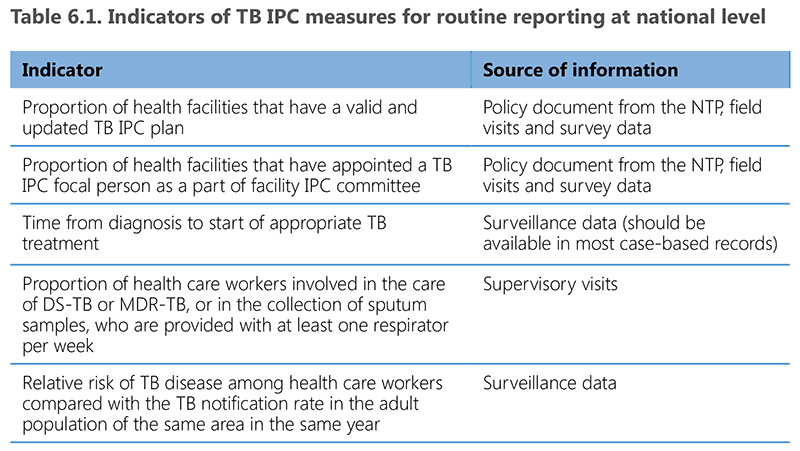Liens transversaux de livre pour 6. Monitoring and evaluation
Monitoring and evaluation are key factors in the success of a TB IPC intervention because they allow progress to be reviewed and plans to be adapted. In contrast to other TB programme interventions, which focus on patient coverage and outcome, much of the monitoring of TB IPC relies heavily on process indicators relating to the enhancement of facilities and changes in behaviour and practices. Monitoring and evaluation addresses questions such as: Is an IPC committee in place? Is triage being performed? Is equipment for mechanical ventilation in place? Has training been conducted?
Programme managers at national, subnational and facility level need to consider how the recording of data on IPC is done; for example, through systematic recording and reporting up to the national level using standard forms or data collected during supervision visits. The monitoring frequency should be annual at least, although some data may only need to be recorded as part of special surveys or implementation research.
Table 6.1 provides a set of five quantifiable indicators for the routine monitoring of key TB IPC measures at national level. It also shows the respective data sources for assessment. The indicator “Time from diagnosis to start of appropriate TB treatment” provides some measure of health system delays that can prolong infectiousness but that could be mitigated through administrative controls. The result would be presented as a mean or median (with ranges) for all patient records. The rate of TB in health care workers, when compared with the TB notification rate in the adult population, should be close to 1 if TB IPC measures are being effectively implemented in health care facilities, exposure is minimized and the risk of acquiring TB is reduced (more details on how to generate and interpret this indicator are given in Annex 1).

DS-TB: drug-susceptible TB; IPC: infection prevention and control; MDR-TB: multidrug-resistant TB; NTP: national TB programme; TB: tuberculosis.
Key points
- Consider which IPC indicators should be routinely monitored at national level for management by the NTP.
- Consider what data should be collected at the subnational and facility level for a useful interpretation of the IPC situation in TB programmes.
A sample checklist of measures that should be in place at national, subnational or facility level to consider alignment with WHO policy guidelines for TB IPC is given in Annex 9; it can be adapted for supervision visits and programme reviews. Annex 1 includes a comprehensive list of variables that may be collected to assess compliance with each of the WHO recommendations given in the guidelines for TB IPC. Data to evaluate such an extensive set of indicators may require separate surveys or implementation research.
 Retour
Retour